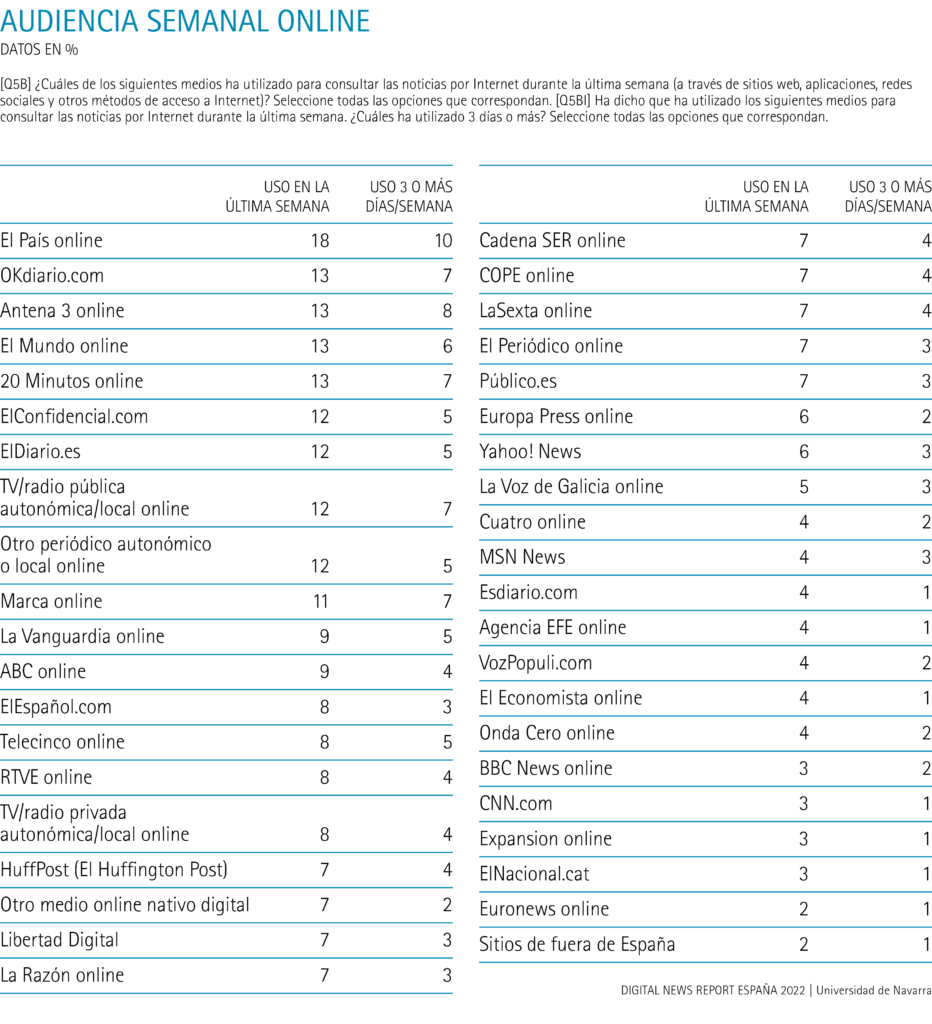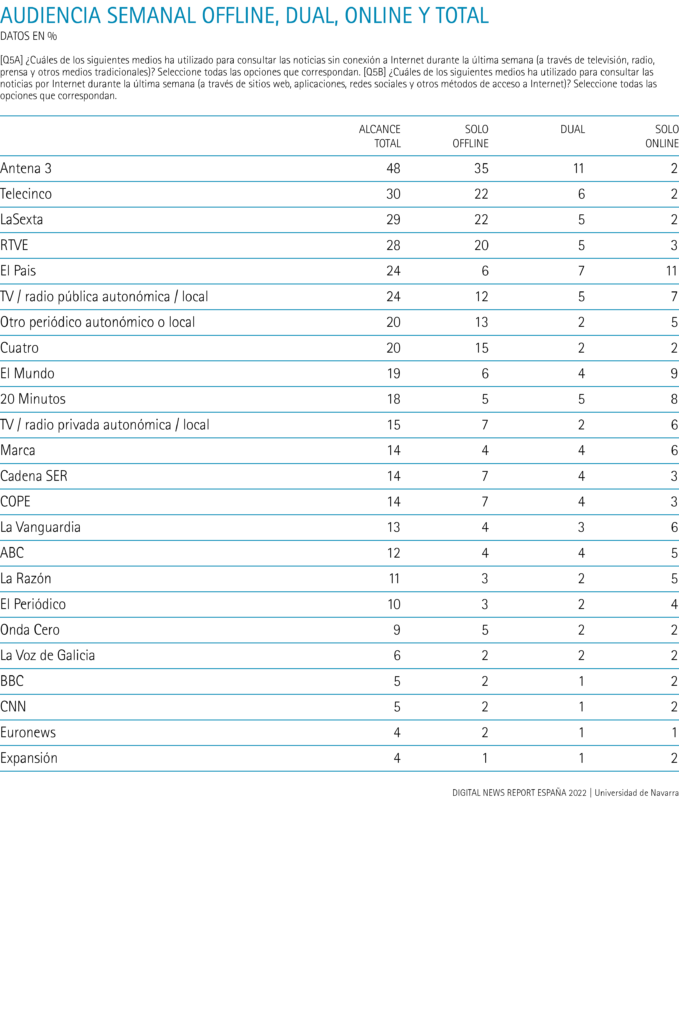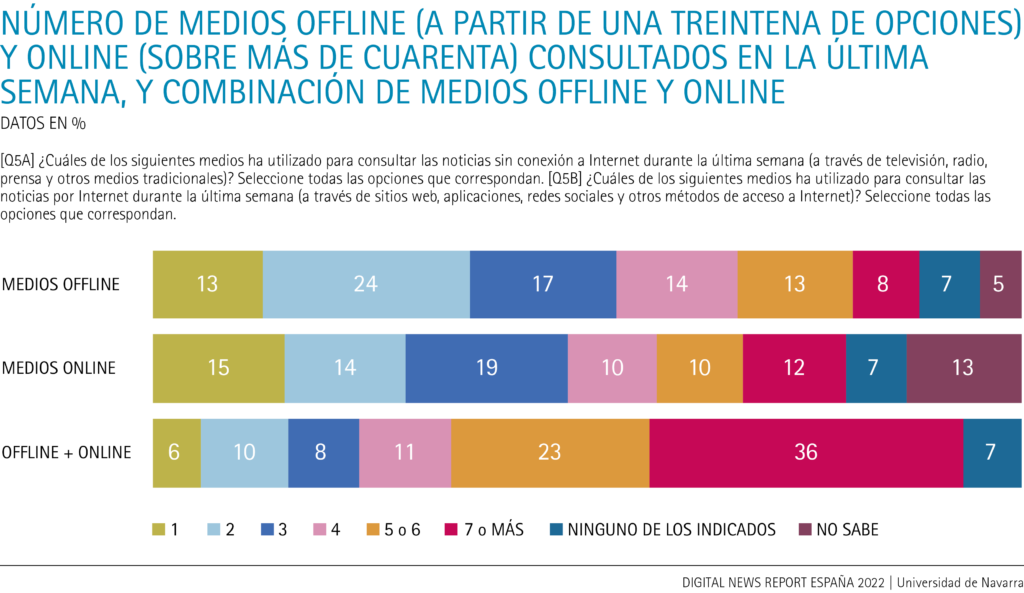-
Antena 3, El Mundo and 20 minutos complete the top 5 in digital news audience, followed by El Confidencial, ElDiario.es, regional radio and television stations, regional and local press, and Marca.
-
48% of users enquiry the news of the first Atresmedia channel between its offline, combined and online versions, which reflects the fact that TV continues to be the medium core topic in the per diem expenses news of Spaniards.
-
Telecinco overtakes La Sexta as the second place in weekly offline news audience, followed closely by RTVE, and all of them reach one out of every four users in their linear offer.
El País online with 18% (three percentage points less than in 2021) once again reaffirms its leadership as the news media with the largest weekly online audience in Spain. However, if we look at the other two places on the podium, changes can be seen. In second place this year we find OKdiario.com (in 2021 it was 20 Minutos online) followed by Antena 3 online, which replaces ElDiario.es. Therefore, the top positions are represented by a traditional newspaper, a digital native media and a generalist television. These three media also stand out for their good user loyalty, with around half or more of their readers visiting them at least three times a week.

The focus on purely digital media consolidates the trend of this type of media at the top of the weekly online audience. ElDiario.es occupied for the first time the third place in 2021 and OKdiario.com surpasses it by reaching the second place in 2022. The presence of purely digital media also extends to ElConfidencial.com and ElDiario.es (both with 12%) occupying the sixth and seventh position respectively. These high audience figures show that digital native media have managed to establish themselves among the media with the largest weekly online audience, despite their more recent historical trajectory. However, this media subject still has room for improvement in terms of reader loyalty, as those who consult ElConfidencial.com and ElDiario.es three times or more during the week do not reach half of their online audience.
Turning to the generalist television channels, once again this year only the online site of the Antena 3 television channel has managed to establish itself among the top ten. This time it climbs from fourth to third place with a 13% audience share (one percentage point less than in 2021). Meanwhile, Telecinco online (8%), RTVE online (8%) and La Sexta online (7%) remain outside the top 10.
If we compare the percentages for 2022 with those of last year, we can see a small generalized drop in weekly online audience in all media. Against this trend, the category of online regional or local public television and radio stands out, which from 10% in 2021 has increased its audience to 12% in the current edition of this survey.

When analyzing the ranking of the traditional media most consumed weekly by Internet users, it can be seen that television channels, as in previous years, continue to occupy the top five positions. In first place is Antena 3 with an audience of 45%, well above the rest of the TV channels. Telecinco (27%), which this year exchanges positions with La Sexta (26%), the second channel of Atresmedia, is 17 percentage points behind. RTVE (25%) and Cuatro (17%) continue to hold their fourth and fifth positions. Therefore, it is possible to appreciate the weight that the generalist television channels maintain in the weekly consumption of news. Even the audiences of a regional or local television and radio (17%) and another regional or local newspaper (15%) are ahead of the newspaper El País (13%) and COPE radio (11%).
Television stations also stand out when looking at the Degree loyalty that users profess towards their news brands. In the case of Antena 3, Telecinco and La Sexta, two thirds of their viewers use the channels three or more days a week. data This contrasts with the print media brands, whose most regular readers do not reach half of their weekly readership. Taking El País as an example, it can be seen that only 5% of all Internet users enquiry three or more times a week, compared to its 13% weekly reach.

When considering the combined offline, dual and online audience, the results of survey show that Antena 3 is once again the news brand of reference letter with 48% of users who consult it on a weekly basis, although this is one percentage point less than last year. Telecinco is 15 points behind, which also takes second place in this combined ranking. Third place goes to La Sexta with 29%.
If we focus our attention on the combined audience of the print media, we can see that 24% of the users of survey consult El País at least once a week. It is noteworthy that, compared to data in 2021, the combined audience of El País leave four percentage points, in line with the trend of lower consumption also suffered by other brands. Regional or local pay newspapers (20%), El Mundo (19%) and 20 Minutos (18%) are the other newspapers that follow El País at some distance. This year the regional and local press category is ahead of El Mundo and 20 Minutos, demonstrating its consolidation.
With respect to the combined audiences of the radio stations, the two radio stations that stand out from the rest are Cadena SER and COPE, with 14% each. With 9 points less, Onda Cero completes the third position. RNE is counted together as part of RTVE.
When comparing the audiences that consume each week the three main TV channels by different means, more than 70% are made up of offline users. On the other hand, only about 5% watch TV channels only through the online variant. In this sense, it can be seen that the vast majority follows TV news coverage through linear broadcasting.
The picture for newspapers, on the other hand, is the opposite, with the balance shifting towards online readership. In other words, over the years, the percentage of online readers of the main national newspapers has already exceeded the percentage of offline readers. An example of this is El País, where 11% of total users enquiry only digitally, compared to 6% who read only offline. It is also noteworthy that the dual audience that consumes the main newspapers either in print or online once a week accounts for around a quarter of the combined audience.
In times of concern about the effects of hoaxes, one way for audiences to protect themselves is through the enquiry of several reliable sources of information. Fifty-nine percent of total users in the study claim to consult five or more offline or online sources of information throughout the week. In this sense, the fact that the contrast of different information sources continues to be a habit among news users in Spain is a positive sign. However, it is also worth noting that this figure has dropped four percentage points compared to last year. It remains to be seen whether this downward trend will continue in the coming years or stabilize. On the other hand, only 16% (three points more than in 2021) are in the habit of consulting one or two sources.

Comparing the issue of offline and online media consulted weekly, it can be highlighted that in the case of offline reading the most selected option is to read two media with 24%. On the other hand, in online reading, the participants of the survey indicated three media with 19% as the most numerous option. The option of reading 5 or more online media amounted to 22%, while in offline media this same option accounted for 21%, very even figures. The combined reading of both types of media provides a substantial increase in the percentage of the Spanish user population that consults 5 or more media (59%).

When analyzing the issue of pure digital media consulted weekly, the data collected at survey shows small differences by gender. Men total 42% and women 39% when consulting 1 or 2 online media. At the other end of the scale, men who consult 3 or more media outlets amount to 14%, while the proportion among women is 9%, five percentage points lower.
The weekly reading of online media shows minor differences by age group. It is worth noting that those over 65 years of age are the ones who consult four or more media per week with 10%, while the rest of the age groups do not reach this percentage.

The overall percentages among online news users in Spain show the greater popularity of online newspaper and magazine media. These account for 59%, five points more than the online-only/mainly online media and the online media of television and radio stations. However, it is noteworthy that online-only media is a category with its own entity in Spain, to the point that 53% of users enquiry during the week have a brand belonging to this category.
If the percentages are compared by gender, no major differences are detected, except that the numbers of men are higher in the three online media modalities.
It can be seen that the popularity of online newspaper and magazine media prevails across all age groups, demonstrating the strength of these brands regardless of the age of Spanish online news users.
When examining the 65+ audience, it can be seen that online media consumption of newspapers and magazines has increased to 70% compared to 60% last year. Online media consumption of television and radio has also increased by twelve percentage points year-on-year.
A souvenir of use survey
Once again this year, the Digital News Report includes questions about the offline and online news media that users recall having consulted at least once in the course of the last week. As an indicator of higher loyalty and frequency of use, users are asked whether they have visited the media three or more times in the last seven days. The results obtained with this method give priority to users' conscious choices, since they are asked to point out those news brands that come to mind when they make report about their news habits. In this way, the study seeks to exclude media visits that have occurred accidentally or inadvertently during users' browsing.
Similarly, it is worth mentioning the existing margin for the surveyed users to favor or omit brands depending on whether they perceive them to be more or less socially acceptable.